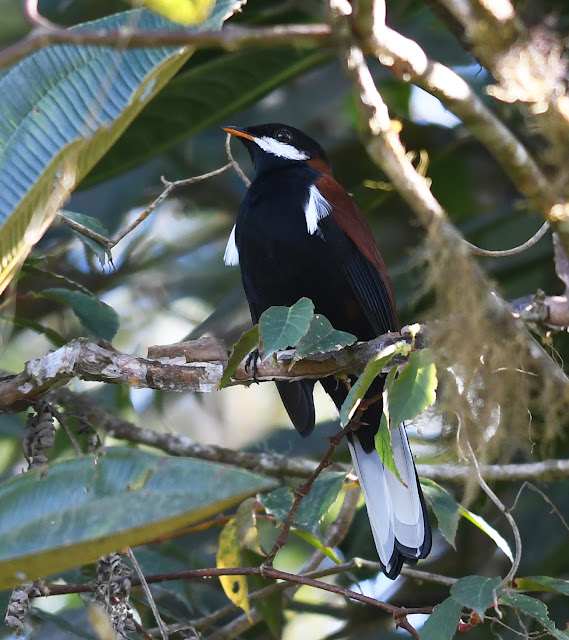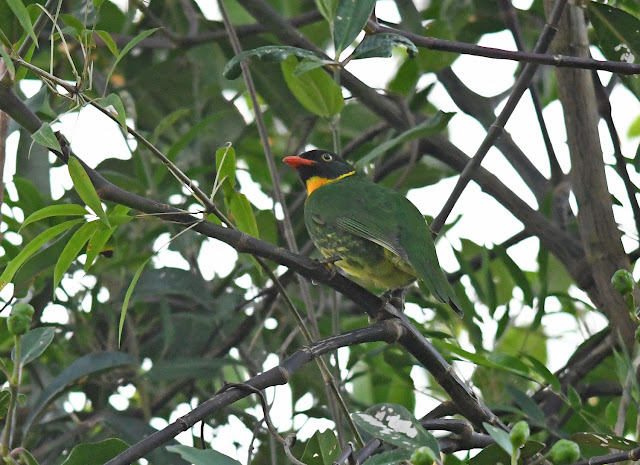The towns of Villa Rica and Oxapampa are often included in central Peru birding itineraries. This lush, fertile region is the coffee-growing capital of Peru. While much of the forest has been cut down and replaced with coffee plantations, these areas also happen to be productive for birding. Though much of the original biodiversity is lost in shade-grown coffee plantations compared to the original forest that once stood here, the plantations happen to be excellent locations to find birds that prefer secondary or edge habitats, as well as species that remain in the treetops such as some tanagers and antwrens.
 |
| Cinnamon Flycatcher - Bosque Shollet, Pasco, Peru |
Additionally, some highly productive forests remain in the Villa Rica and Oxapampa areas, such as Bosque Shollet and the massive Parque Nacional Yanachaga Chemillen. Many scarce east-slope species can be found here and elsewhere in the region.
Laura and I had already cleaned up nearly all of our target birds in this part of Peru due to our very successful visit to Hacienda Armorique. We decided to spend a few days anyways in Villa Rica and Oxapampa. Unfortunately, our visit coincided with a national holiday in Peru, and Villa Rica and Oxapampa are very popular vacation destinations for local Peruvians. Oxapampa, in particular, has a unique ambience as it was founded by German and Austrian immigrants many years ago. For local Peruvians hoping to get their German experience, complete with chalet-style hotels and German biergartens, this is the place to be.
July 27, 2022
We left our Villa Rica hotel shortly after dawn and drove to nearby Bosque Shollet. This protected area is situated partway along the road connecting Villa Rica and Oxapampa and it is a well-known birding site. We discovered that this road, typically in poor condition, had been recently graded. While it expedited our journey to the site, it also meant that traffic levels were increased since this route facilitated a somewhat rapid journey between Villa Rica and Oxapampa, despite the winding route through the mountains.
 |
| Bosque Shollet, Pasco, Peru |
We dodged traffic all morning which was rather annoying. This was especially grating whenever I would attempt to record a bird's vocalization and a distant vehicle's engine would encroach into the recording. We also had no luck finding Black-winged Parrots, a species with a limited range in the eastern Andes and which is sometimes reported from here.
 |
| Begonia peruviana - Bosque Shollet, Pasco, Peru |
However, we quickly found two new species for our life lists in Rufous-vented and Trilling Tapaculos, while Bay and Leymebamba Antpittas were heard singing down a heavily vegetated slope. The birding was relatively slow for the first hour or two and I had no luck with many of my targets early on, including Masked Fruiteater, Buff-browed Foliage-gleaner, Variable Antshrike and Rufous-bellied Bush-Tyrant.
Our luck began to turn during the mid-morning hours. First, we found a very cooperative White-eared Solitaire, a spectacular species that was a lifer for Laura and my first sighting (I had previously heard one along the Satipo Road).
 |
| White-eared Solitaire - Bosque Shollet, Pasco, Peru |
A little while later, we heard a Masked Fruiteater as we were picking through a large mixed flock that contained Flame-faced Tanager, Capped Conebill, Streaked Tuftedcheek and more amongst far too many Common Chlorospingus. Despite considerable effort, the fruiteater would not come in any closer, nor would the Rufous-bellied Bush-Tyrant that we heard later on.
 |
| Inca Flycatcher - Bosque Shollet, Pasco, Peru |
We kept adding birds into the early afternoon including Yellow-scarfed Tanager, White Hawk and Streak-headed Antbird.
 |
| Hook-billed Kite - Bosque Shollet, Pasco, Peru |
Shortly after lunch, I speculatively played the tape of the Chestnut-crested Cotinga, a somewhat scarce species that we had never bumped into despite spending a considerable amount of time in its range in Colombia. Suddenly, two thrush-sized birds zipped into the bare branches of a tree directly in line with the sun. Cotingas!
Despite the poor lighting we could appreciate their distinctive features and I fired off a few reasonable photos given the circumstances. We would see another one on the following day as we drove back through Bosque Shollet. A super cool bird!
 |
| Chestnut-crested Cotingas - Bosque Shollet, Pasco, Peru |
We finished up our birding by discovering our lifer Buff-browed Foliage-gleaner down a steep slope, an excellent end to a fairly productive birding day, despite the traffic.
July 28, 2022
We rose early from our hotel in Oxapampa and drove to a nearby eBird hotspot called Camino a San Alberto. I had originally wanted to explore another area, Carretera Antenna, but it was impossible to find any information whatsoever as to the exact location of this road or how to access it. It apparently traverses high quality cloud forest in the mountains east of Oxapampa.
Instead, we birded the San Alberto road which passes through disturbed areas until the road peters out. From here, a footpath/ATV trail continues into the hills, but it was not maintained by the national park and became quite overgrown after another kilometre or two. We still enjoyed a few hours of birding despite these setbacks. And best of all, we succeeded in avoiding the hoards of local tourists that had descended on Oxapampa.
 |
| Trail beyond Camino a San Albert, Pasco, Peru |
Laura and I were still eating breakfast beside our parked car when a distinctive, extremely high call caught our ears. The Masked Fruiteater! Making amends for the previous day's failure, we actually managed to see this one. Though the sun had not yet crested the horizon, the views were pretty good as the bird was basically at eye level.
 |
| Masked Fruiteater - Camino a San Albert, Pasco, Peru |
The Masked Fruiteater is a type of cotinga that resides in humid montane forests on the east slope of the Peruvian Andes. Like many other species we had bumped into, it is endemic to Peru.
 |
| Masked Fruiteater - Camino a San Albert, Pasco, Peru |
A little later, we observed our second ever Buff-browed Foliage-gleaner. This one was quite territorial and allowed extended views and a chance at photos, though I never managed anything better than record shots.
 |
| Buff-browed Foliage-gleaner - Camino a San Albert, Pasco, Peru |
The morning was calm, cool, and brilliantly sunny. Birds were singing, butterflies were fluttering by, and there were no other people within earshot. Pure bliss.
 |
| Perisama sp. - Camino a San Albert, Pasco, Peru |
We encountered a few other birds for the first time including a singing Pale-legged Warbler and a Green-and-White Hummingbird. The latter is a rather drab species which has a limited range in central and southern Peru. The best way to differentiate it from the very similar White-bellied Hummingbird is by the amount of white on the underside of the tail feathers. Whoever figured out that two different species were involved must have been a very observant individual!
 |
| Green-and-white Hummingbird - Camino a San Albert, Pasco, Peru |
This pair of Blue-banded Toucanets was taking advantage of the glorious morning. You could say that the toucanets were creating four-canets.
 |
| Blue-banded Toucanets - Camino a San Albert, Pasco, Peru |
 |
| Blue-banded Toucanets - Camino a San Albert, Pasco, Peru |
We were in for one final surprise during our hike back to the car. A pair of Silvery Tanagers alighted in a nearby tree! The male allowed incredible views, while the pretty female was a little more furtive.
 |
| Silvery Tanager - Camino a San Albert, Pasco, Peru |
Laura and I left the tourists of Oxapampa behind and navigated the mountain road back towards Villa Rica. We made our standard lunch of trunk sandwiches at Bosque Shollet, though birding was pretty slow given the time of day. A nice little trail system leaves the road and passes near some of the wetlands found in this unique, boggy habitat.
 |
| Bosque Shollet, Pasco, Peru |
We marveled at the plants, while I kept an eye to the sky for Solitary Eagles (no luck, since they do not exist) and an ear out for Black-winged Parrots (ditto).
 |
| Excremis coarctica - Bosque Shollet, Pasco, Peru |
 |
| Paepalanthus sp. - Bosque Shollet, Pasco, Peru |
 |
| Epidendrum catillus - Bosque Shollet, Pasco, Peru |
Our plan that evening was to explore Laguna El Oconal, a large lake just outside of Villa Rica that also happens to be a productive birding location. Unfortunately, the holiday week was still ongoing, and throngs of people were out enjoying the sunny Sunday afternoon. We turned back from the crowds, resolving to return early the next morning for a slightly more peaceful (and birdier) experience.
July 29, 2022
This was a good decision. The crowds were nowhere to be seen, and though we had to contend with an endless parade of motos and tuk-tuks, at least the birding was fantastic.
 |
| Laguna El Oconal, Pasco, Peru |
As the sun rose we watched a pair of Rufous-sided Crakes emerge from the reeds, while all of the standard marsh birds made appearances. We even enjoyed a fly-by of two Brazilian Teals, a species which is quite rare in Peru but has colonized this lake in recent years.
 |
| Laguna El Oconal, Pasco, Peru |
 |
| Limpkin - Laguna El Oconal, Pasco, Peru |
Bird diversity is relatively high around the lake due to the combination of different habitats. I photographed a Mouse-colored Tyrannulet for the first time while we also enjoyed Red-capped Cardinals, Chivi Vireos, Least Grebes and Barred Antshrikes.
 |
| Mouse-colored Tyrannulet - Laguna El Oconal, Pasco, Peru |
 |
| Wattled Jacana - Laguna El Oconal, Pasco, Peru |
Sick of the constant traffic, we left the northeastern side of the lake to venture over to the southwestern part. This was a good decision - traffic was practically nonexistent and the birding remained steady.
 |
| Laguna El Oconal, Pasco, Peru |
The lack of traffic meant that we discovered a Little Ground-Tyrant perched on the road. While all of the other ground-tyrant species reside in the rocky and grassy environs of the high Andes, the Little Ground-Tyrant bucks the trend and lives in the Amazon and foothills of the Andes. This was a milestone bird for me, as it was my 13th and final species of Muscisaxicola ground-tyrant.
 |
| Little Ground-Tyrant - Laguna El Oconal, Pasco, Peru |
We observed a pair of Rufous-fronted Tody-Flycatchers, a species that we had previously heard in Mitú, Colombia but had never observed before.
 |
| Rusty-fronted Tody-Flycatcher - Laguna El Oconal, Pasco, Peru |
 |
| Rusty-fronted Tody-Flycatcher - Laguna El Oconal, Pasco, Peru |
Having read that Subtropical Doraditos can be found on the lake I kept watch for suitable patches of Schoenoplectus bulrushes. We found a patch, I played a snippet of tape, and one popped up!
 |
| Subtropical Doradito - Laguna El Oconal, Pasco, Peru |
This is a species that we had seen before (near Otavalo, Ecuador, and in southern Colombia) but it was nice to reacquaint ourselves with one.
 |
| Subtropical Doradito - Laguna El Oconal, Pasco, Peru |
We heard a Blackish Rail sounding off, our final target bird that we had hoped to encounter at Laguna Oconal. It remained out of sight, unfortunately. And with that we hit the road, aiming for the highlands of Junín.
































No comments:
Post a Comment